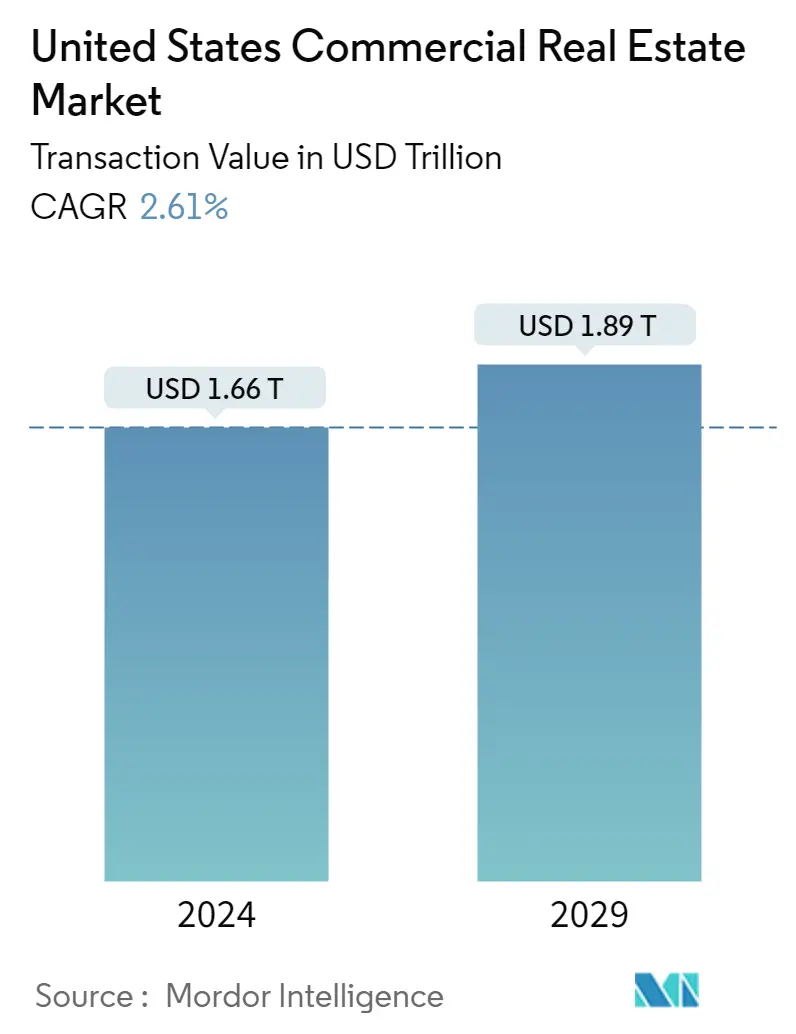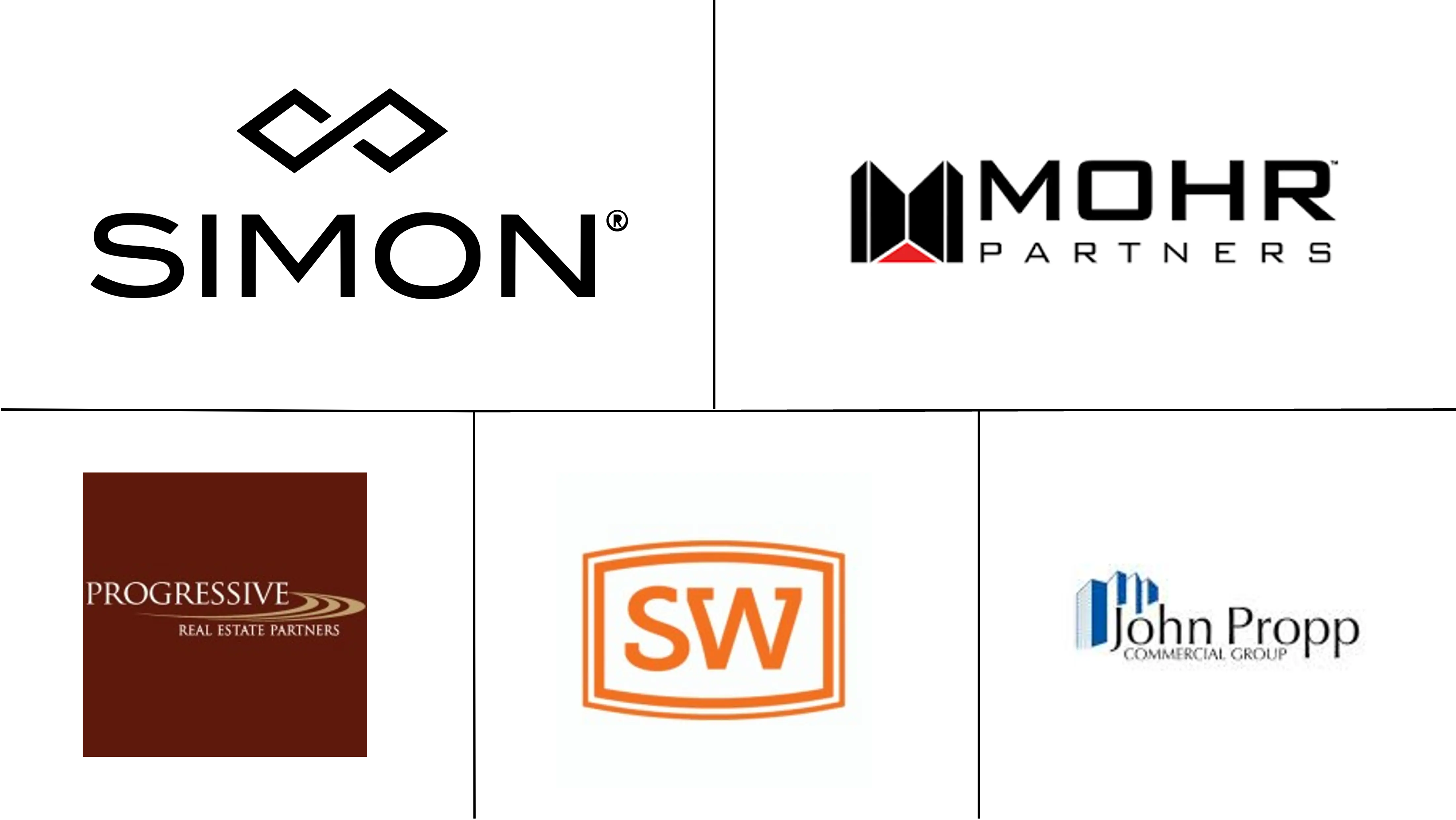Market Size of United States Commercial Real Estate Industry

| Study Period | 2020 - 2029 |
| Base Year For Estimation | 2023 |
| Market Size (2024) | USD 1.66 Trillion |
| Market Size (2029) | USD 1.89 Trillion |
| CAGR (2024 - 2029) | 2.61 % |
| Market Concentration | Low |
Major Players
*Disclaimer: Major Players sorted in no particular order |
Need a report that reflects how COVID-19 has impacted this market and its growth?
US Commercial Real Estate Market Analysis
The United States Commercial Real Estate Market size in terms of transaction value is expected to grow from USD 1.66 trillion in 2024 to USD 1.89 trillion by 2029, at a CAGR of 2.61% during the forecast period (2024-2029).
While the COVID-19 pandemic continued to impact the US real estate market, specific sectors began to show signs of moderate recovery throughout 2021. With the deployment and increasing availability of COVID-19 vaccines during Q1 and Q2 2021, many US states completed phased "re-openings" of their economies, ending stay-at-home and lockdown orders and eliminating real estate capacity restrictions. These measures drove up the consumer demand for goods and services, which was subdued throughout the lockdown. This demand resulted in a modest increase in performance among previously-depressed markets, particularly hospitality, through mid-2021.
Driven by a marked increase in leisure travel, the monthly hotel occupancy rate in the country returned to near pre-pandemic levels during the summer of 2021, with a 69.6% monthly occupancy rate by the end of July, the highest since August 2019.
Retail vacancy levels decreased slightly through mid-2021, continuing a slightly encouraging downward trend that began in Q4 2020. Similarly, a push toward the end of remote work in many industries resulted in a significant quarterly decrease in the rate of new vacancies in Q2 2021.
Despite these positive developments, the overall vacancy levels for the hotel and office sectors remain above pre-pandemic levels, due in part to continued remote work and the lack of a rebound in business travel due to the pandemic. For example, the total US hotel occupancy rate by the end of Q2 2021 was down by 17% compared to Q2 2019. Similarly, the overall national office vacancy level increased by 50 basis points in Q2 2021 to 16.5%. This is just below the peak vacancy level of 16.8%, which was recorded following the global financial crisis of 2008. Based on the current speeds of increase in occupancy levels, a full recovery in either sector is not expected until late 2022.
In the retail sector, despite the decreases evidenced in Q1 and Q2 2021, vacancy levels remain at historic highs due to the continued shift in consumer sentiment towards online shopping and rising inflation resulting in part from the pandemic.
US Commercial Real Estate Industry Segmentation
Commercial property refers to real estate used for commercial activities, like offices and large rental residential properties. The owners of these buildings or lands need to pay additional taxes in compliance with the government's policies and laws. These buildings are rented out to generate a profit, either from capital gains or rental income.
The report provides key insights into the US Commercial Real Estate market. It includes the technological developments, the trends, and the initiatives taken by the government in this sector. The report sheds light on the factors driving the market, restraints to the market growth, and opportunities. Additionally, the competitive landscape of the commercial real estate market is depicted through the profiles of key players.
The market is segmented by type (office, retail, industrial, logistics, hospitality, and multi-family) and key city (New York, Chicago, Los Angeles, San Francisco, Boston, Denver, Houston, Phoenix, Atlanta, and Salt Lake City). The report offers the market size and forecasts in terms of value (USD billion) for all the above segments.
| By Type | |
| Offices | |
| Retail | |
| Industrial | |
| Logistics | |
| Multi-family | |
| Hospitality |
| By Key City | |
| New York | |
| Chicago | |
| Los Angeles | |
| San Francisco | |
| Boston | |
| Denver | |
| Houston | |
| Phoenix | |
| Atlanta | |
| Salt Lake City |
United States Commercial Real Estate Market Size Summary
The US Commercial Real Estate Market is projected to see significant growth over the forecast period. This growth is expected to be driven by the increasing transaction value in the market. However, the impact of the COVID-19 pandemic has been felt across the sector, with some areas showing signs of moderate recovery throughout 2021. This recovery was facilitated by the lifting of lockdown orders and the elimination of real estate capacity restrictions in many US states, which led to a surge in consumer demand for goods and services. This increased demand resulted in a modest performance improvement in previously-depressed markets, particularly in the hospitality sector. Despite some positive developments, the overall vacancy levels in the hotel and office sectors remain higher than pre-pandemic levels. This is mainly due to the continued prevalence of remote work and the lack of a rebound in business travel due to the pandemic. In the retail sector, vacancy levels remain at historic highs due to the continued shift in consumer sentiment towards online shopping and rising inflation resulting from the pandemic. However, the US commercial real estate market ended 2021 with unprecedented demand, exceptionally low vacancy rates, and record-setting rental growth in the industrial sector. This sector benefited from supply chain reconfigurations and a surge in online shopping.
Explore MoreUnited States Commercial Real Estate Market Size - Table of Contents
-
1. MARKET INSIGHTS
-
1.1 Current Economic Scenario and Consumer Sentiment
-
1.2 Commercial Real Estate Buying Trends - Socioeconomic and Demographic Insights
-
1.3 Government Initiatives for and Regulatory Aspects of the Commercial Real Estate Sector
-
1.4 Insights into Existing and Upcoming Projects
-
1.5 Insights into Interest Rate Regime for General Economy and Real Estate Lending
-
1.6 Insights into Rental Yields in the Commercial Real Estate Segment
-
1.7 Insights into Capital Market Penetration and REIT Presence in Commercial Real Estate
-
1.8 Insights into Public-private Partnerships in Commercial Real Estate
-
1.9 Insights into Technologies and Startups in Real Estate (broking, social media, facility management, property management)
-
1.10 Impact of COVID-19 on the Market
-
-
2. MARKET SEGMENTATION
-
2.1 By Type
-
2.1.1 Offices
-
2.1.2 Retail
-
2.1.3 Industrial
-
2.1.4 Logistics
-
2.1.5 Multi-family
-
2.1.6 Hospitality
-
-
2.2 By Key City
-
2.2.1 New York
-
2.2.2 Chicago
-
2.2.3 Los Angeles
-
2.2.4 San Francisco
-
2.2.5 Boston
-
2.2.6 Denver
-
2.2.7 Houston
-
2.2.8 Phoenix
-
2.2.9 Atlanta
-
2.2.10 Salt Lake City
-
-
United States Commercial Real Estate Market Size FAQs
How big is the United States Commercial Real Estate Market?
The United States Commercial Real Estate Market size is expected to reach USD 1.66 trillion in 2024 and grow at a CAGR of 2.61% to reach USD 1.89 trillion by 2029.
What is the current United States Commercial Real Estate Market size?
In 2024, the United States Commercial Real Estate Market size is expected to reach USD 1.66 trillion.

